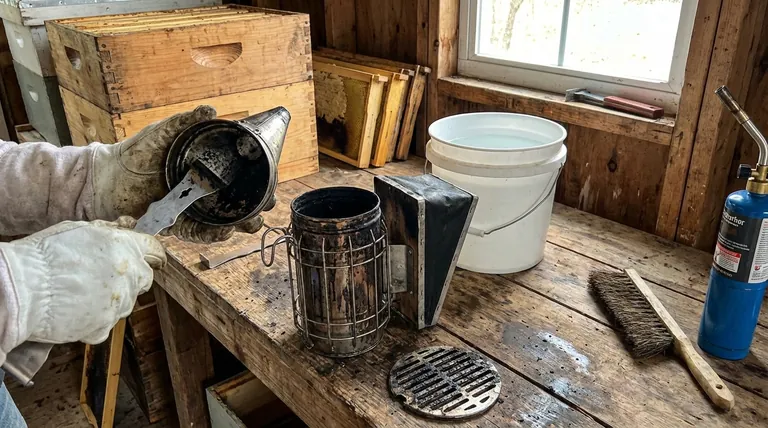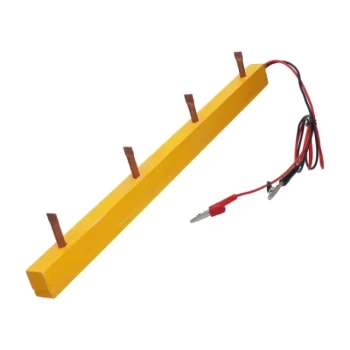While the canister and lid are the most obvious areas for cleaning, a truly functional and safe hive smoker requires attention to all its components. Soot and charred debris collect throughout the device, impacting airflow and performance. A full, thorough cleaning should be performed at least once a year.
The core principle of smoker maintenance is balancing routine upkeep with deep cleaning. While frequent scraping of the lid and canister keeps it working day-to-day, a full annual disassembly and wash is essential for preventing critical clogs and ensuring no harmful residues affect your bees.

The Anatomy of Buildup: Where and Why Soot Collects
Understanding where residue accumulates is key to efficient cleaning. The primary culprit is soot from incomplete combustion, which can clog critical airflow pathways.
The Canister and Lid
The upper section of the canister and the underside of the lid are where the most significant, visible sooty buildup occurs.
This charred debris can eventually prevent the lid from closing properly, interfering with the smoker's function. A modified hive tool is an excellent scraper for this heavy accumulation.
The Airflow Tube and Hole
The tube connecting the bellows to the canister is a critical chokepoint. Soot can harden inside this tube, severely restricting or completely blocking the puff of air needed to keep fuel smoldering.
Likewise, the air hole at the base of the bellows can become clogged, preventing air from entering in the first place.
The Bellows
Debris and soot can be drawn back into the bellows during operation. Over time, this buildup can cause the material to become stiff, wear out prematurely, or fail to draw in a sufficient volume of air.
The Base Grate
If your smoker includes a removable base grate or stand, it can become clogged with ash and unburnt fuel. This impedes airflow from the bottom, making it much harder to keep the smoker lit.
Understanding the Trade-offs: Cleaning Methods and Bee Safety
Your cleaning method has direct consequences for the health of your hive. The goal is to remove buildup without introducing harmful substances.
The Risk of Abrasives and Chemicals
Never use abrasive cleaners that contain toxic materials or harsh chemicals. These substances can leave residues within the smoker that will be vaporized during the next use and puffed directly into the hive, harming or killing your bees.
Water and Scraping: The Safest Method
The safest approach is to use hot water and physical scraping. Disassemble the smoker and soak the metal components to loosen the creosote and soot, then scrape and scrub them clean.
The "Torching" Safeguard
If you must use any kind of cleaning product, it is critical to torch the smoker thoroughly afterward. Heating the metal components with a propane torch helps burn off any residual chemicals, ensuring they don't contaminate the hive.
Making the Right Choice for Your Goal
Your maintenance schedule should align with your beekeeping priorities.
- If your primary focus is immediate performance: Regularly scrape the lid and ensure the airflow tube is clear before each hive inspection.
- If your primary focus is long-term durability: Perform a full disassembly and deep cleaning at least once a year to protect the bellows and prevent corrosion.
- If your primary focus is absolute bee safety: Stick to water and scraping for cleaning, avoiding all chemical agents to eliminate the risk of contamination.
A clean smoker is a reliable tool that ensures calm inspections and a healthy hive.
Summary Table:
| Part to Clean | Why It's Important | Key Risk if Neglected |
|---|---|---|
| Canister & Lid | Prevents lid from sticking; removes visible soot buildup | Poor smoke control; inefficient operation |
| Airflow Tube & Hole | Ensures consistent air supply for smoldering fuel | Complete airflow blockage; smoker won't stay lit |
| Bellows | Maintains flexibility and air volume for effective puffing | Stiff, worn-out bellows; reduced air intake |
| Base Grate | Allows proper airflow from the bottom of the smoker | Difficulty keeping smoker lit; ash clogging |
Keep Your Apiary Running Smoothly with Professional-Grade Equipment
A clean, well-maintained hive smoker is essential for successful beekeeping. For commercial apiaries and beekeeping equipment distributors, reliable tools are non-negotiable.
HONESTBEE supplies durable, professional beekeeping supplies and equipment through wholesale-focused operations. Our products are designed for the demands of commercial beekeeping, ensuring longevity and consistent performance season after season.
Ready to upgrade your apiary's equipment? Contact HONESTBEE today to discuss wholesale pricing and discover how our professional-grade supplies can enhance your beekeeping operations.
Visual Guide

Related Products
- HONESTBEE Advanced Ergonomic Stainless Steel Hive Tool for Beekeeping
- Premium Traditional Copper Bee Smoker with Bellows
- Professional Dual-End Stainless Steel Hive Tool for Beekeeping
- Professional 3-Bar Frame Grip with Integrated Hive Tool
- Yellow Plastic Bucket Pail Perch for Beekeeping
People Also Ask
- What are the basic tools for beekeeping? Essential Starter Kit for Safe & Successful Hive Management
- How is a hive tool used for scraping and cleaning? Master Hive Maintenance for a Healthy Colony
- What are the features of a regular hive tool? The Essential Multi-Tool for Every Beekeeper
- What are some common uses of a hive tool? Essential Multi-Purpose Tool for Every Beekeeper
- Why do hive tools have a hole? Unlock the Secret to Efficient Beekeeping



















